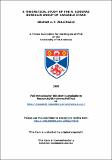Files in this item
A theoretical study of the R. Coronae Borealis group of variable stars
Item metadata
| dc.contributor.advisor | Carson, T. R. (Thomas Richard) | |
| dc.contributor.author | Willingale, Graham A. P. | |
| dc.date.accessioned | 2014-04-29T10:51:44Z | |
| dc.date.available | 2014-04-29T10:51:44Z | |
| dc.date.issued | 1989 | |
| dc.identifier | uk.bl.ethos.571495 | |
| dc.identifier.uri | https://hdl.handle.net/10023/4656 | |
| dc.description.abstract | A theoretical study of the R Coronae Borealis group of variables is presented. A modified Christy code is used for the non-linear calculations and Dr Worrell's codes are used for the linear calculations. These codes are used in conjunction with both Carson and Los Alamos opacity tables, following the work of Saio on the linear analysis of Hydrogen deficient Carbon stars. 630 linear models are presented in 3 surveys along with 10 non-linear models of RCB stars and 20 incidental models used for comparison purposes. A study of the observations, given in the literature showed that the masses and luminosities of these stars are poorly defined. A linear analysis of 7 of these stars, in conjunction with observations given in literature, has allowed luminosity limitations to be placed on seven of these stars, and for the two stars which also have spectroscopic data a rough mass was calculable. The spectroscopic mass and luminosity limits of R CrB are (0.96 +1- 0.07)M☉ and (9,500 - 16,500)L☉ and for BY Sgr are (0.95 +1- 0.06)M☉ and (9,000 - 13,000)L☉. A non-linear model of RY Sgr using the best mass and luminosity produced a light curve that agreed well with the overall characteristics of the observations, i.e., period, amplitude m and semi-regularity. Another of the non-linear models showed a 7ᵐ drop in its luminosity curve, which lasted for about twenty days. This is greatly short of the months to years seen in the observations, but could be suggestive of the initiation of the 'deep minimum' phenomenon. It was followed by the rapid outward movement of all the outer zones, which could indicate a method of ejecting carbon grains. Further research needs to be done before any conclusions can be drawn. The non-linear analysis of the 5,000K and 6,000K models may indicate that the effective temperatures given in the literature for these stars are too low, as a value nearer 7,000K seems to give better results. From this analysis, it seems that the majority of the ReB group of stars have masses in the range (0.8 - 1.2)M☉, which is consistent with the evolutionary analysis of Weiss. | en_US |
| dc.language.iso | en | en_US |
| dc.publisher | University of St Andrews | |
| dc.rights | Creative Commons Attribution-NonCommercial-NoDerivatives 4.0 International | |
| dc.rights.uri | http://creativecommons.org/licenses/by-nc-nd/4.0/ | |
| dc.subject.lcc | QB837.W5 | |
| dc.subject.lcc | QK828.C3O6 | |
| dc.title | A theoretical study of the R. Coronae Borealis group of variable stars | en_US |
| dc.type | Thesis | en_US |
| dc.type.qualificationlevel | Doctoral | en_US |
| dc.type.qualificationname | PhD Doctor of Philosophy | en_US |
| dc.publisher.institution | The University of St Andrews | en_US |
This item appears in the following Collection(s)
Except where otherwise noted within the work, this item's licence for re-use is described as Creative Commons Attribution-NonCommercial-NoDerivatives 4.0 International
Items in the St Andrews Research Repository are protected by copyright, with all rights reserved, unless otherwise indicated.


